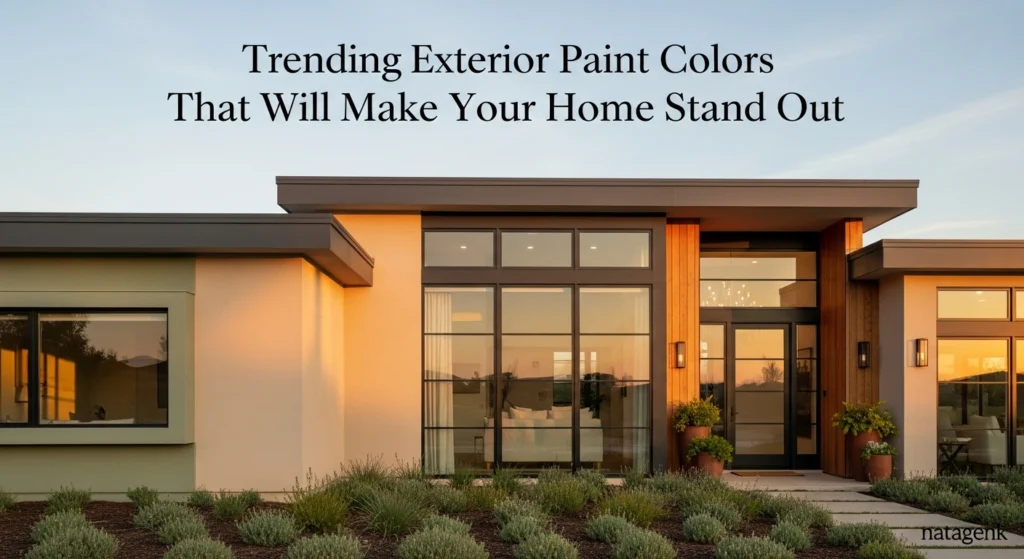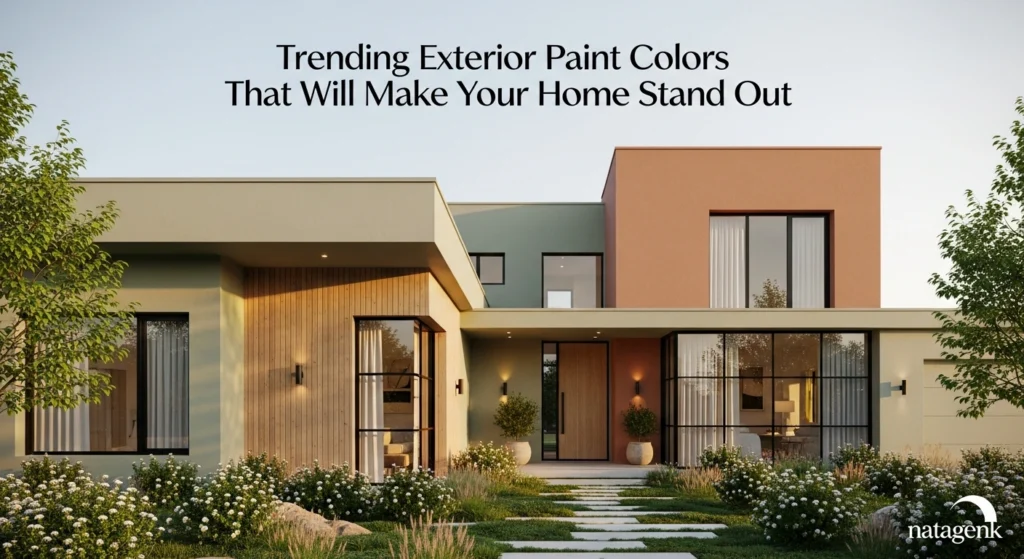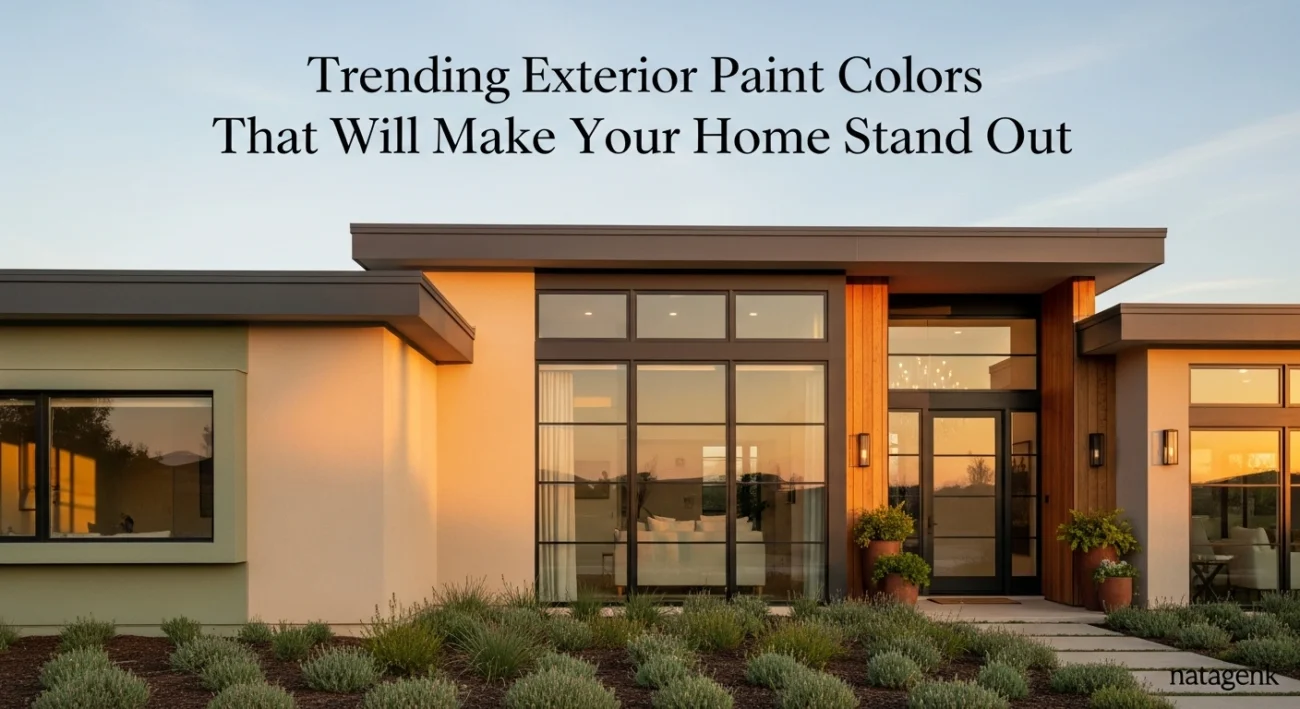Trending Exterior Paint Colors That Will Make Your Home Stand Out
Trending Exterior Paint Colors That Will Make Your Home Stand Out – The exterior of your home is its first impression to the world. It is a public declaration of your style and a significant factor in your neighborhood’s overall aesthetic. Choosing the right paint color is one of the most impactful and cost-effective ways to boost curb appeal, increase property value, and create a home you’re proud to return to every day.
This decision, however, can feel overwhelming with a seemingly endless spectrum of shades available. This guide will navigate you through the latest trends and timeless classics in exterior house paint colors. We will help you find the perfect palette to make your home a true standout.

Why Your Exterior Paint Choice Matters So Much
Selecting exterior house paint colors is about more than just aesthetics; it’s a strategic decision with long-lasting implications. The right choice can dramatically transform a property’s presence and perceived value. It is the first thing a potential buyer sees and the last thing you see when you leave for the day.
A well-chosen color scheme acts as a protective shield for your home’s siding against the elements. Quality paint helps to guard against moisture, UV damage, and temperature fluctuations, preserving the structural integrity of your home. Therefore, the investment goes far beyond simple decoration.
Moreover, the colors you choose are a powerful form of self-expression. They can reflect your personality, whether you are drawn to bold and dramatic statements or calm and serene hues. The right palette makes a house feel truly like a home, tailored to your personal taste.
The right exterior house paint colors can also highlight your home’s best architectural features. A thoughtful color placement can draw attention to beautiful trim work, a grand entryway, or unique structural details. Conversely, a poor choice can make these same features recede or clash.
Finally, your home exists within a community. While you want your house to stand out, it should also feel like it belongs. Choosing exterior house paint colors that complement the neighborhood and natural surroundings shows a respectful consideration for the shared environment.
Top Trending Exterior House Paint Colors
The world of exterior design is constantly evolving, with certain color families rising in popularity. Today’s trends lean towards colors that feel sophisticated, connected to nature, and emotionally resonant. These palettes move away from the basic beiges of the past and into more nuanced and character-filled territory.
We are seeing a significant shift towards colors that evoke a sense of calm and stability. Homeowners are seeking shades that create a sanctuary, a retreat from the busy outside world. This has led to the rise of earthy tones, deep moody hues, and sophisticated, warm whites.
This section will explore the most popular trends in exterior house paint colors right now. We will provide specific examples and guidance on how to use them effectively. These trends offer a range of options suitable for various architectural styles.
Embracing Nature: Earthy Tones and Greens
Connecting with the natural world has become a powerful theme in home design, and this extends to exterior house paint colors. Earthy tones ground a home in its landscape, creating a seamless and organic feel. These colors are calming, timeless, and incredibly versatile.
Sage green, in particular, has emerged as a frontrunner in this category. A color like Sherwin-Williams’ “Evergreen Fog” or Benjamin Moore’s “October Mist” offers a soft, muted green with gray undertones. This makes it sophisticated rather than overpowering.
These gentle greens work beautifully on a variety of home styles, from modern farmhouses to traditional Craftsman bungalows. They pair exceptionally well with natural materials like wood and stone. For trim, consider a creamy off-white or a deep charcoal for a touch of contrast.
Other popular earthy tones include warm taupes, muted clays, and deep olive greens. These shades bring a sense of warmth and history to a home’s facade. They are excellent choices for homeowners who want a color with personality that still feels classic and widely appealing. This is a safe yet stylish category of exterior house paint colors.
Bold and Dramatic: Dark and Moody Hues
For those looking to make a confident and contemporary statement, dark exterior house paint colors are the definitive choice. Shades of deep charcoal, bold navy, and even black are being used to create stunning, high-impact facades. These colors are dramatic, elegant, and surprisingly versatile.
A deep charcoal gray, like Benjamin Moore’s “Kendall Charcoal,” provides a strong, modern look without the harshness of pure black. It creates a perfect backdrop for lush green landscaping and warm wood accents. This color is particularly effective on homes with clean lines and modern architecture.
Similarly, dark navy blue, such as Sherwin-Williams’ “Naval,” offers a classic yet bold alternative. It feels both traditional and fresh, evoking a sense of nautical sophistication. Navy pairs beautifully with crisp white trim for a timeless look or with copper accents for a more modern-industrial feel.
Using these dark colors requires confidence, but the payoff can be immense. They make a home look substantial and well-defined, drawing attention to its form and structure. When considering these dramatic exterior house paint colors, it’s crucial to ensure you have enough natural light to prevent the home from feeling overly somber.
Timeless Sophistication: Warm and Creamy Whites
White is a classic choice for home exteriors, but the current trend is moving away from stark, cold whites. Instead, homeowners are embracing warm, creamy, and soft off-whites. These shades provide a clean and timeless look while feeling much more inviting and gentle on the eyes.
Colors like Benjamin Moore’s “White Dove” or Sherwin-Williams’ “Alabaster” have a subtle warmth that prevents them from looking sterile. They create a bright and welcoming facade that feels both fresh and classic. This trend is particularly popular for the modern farmhouse style but works on virtually any type of home.
The beauty of a warm white exterior is its versatility as a canvas. It allows other features, such as a brightly colored front door, black window frames, or stone accents, to truly pop. This choice of exterior house paint colors ensures your home will never look dated.
When choosing a white, it is essential to test samples outside, as the natural light will significantly impact the final look. A white that looks perfectly warm on a paint chip can appear starkly bright in direct sunlight. A creamy off-white provides a softer, more nuanced appearance that looks sophisticated in all lighting conditions.

Factors to Consider Before Choosing Your Exterior House Paint Colors
Picking a color from a trend list is a great starting point, but the perfect choice for your home depends on several unique factors. A color that looks stunning on a modern home in a sunny climate might look out of place on a historic home in a wooded area. Before you commit, it is vital to take a holistic view of your property and its surroundings.
Thinking through these factors will help you narrow down your options and avoid costly mistakes. A successful exterior color scheme is one that feels intentional and harmonious with all the elements of your property. Proper consideration of these aspects is key to selecting the best exterior house paint colors.
You must analyze your home’s architecture, its permanent features like the roof and stonework, and the quality of natural light it receives. The surrounding landscape and neighborhood context also play a crucial role. This thoughtful approach will ensure your chosen colors enhance your home’s beauty for years to come.
Architectural Style and Your Neighborhood
The architectural style of your home provides a strong set of clues for appropriate exterior house paint colors. Certain styles have historical color palettes that are designed to accentuate their specific features. While you don’t have to adhere strictly to history, using it as a guide can lead to a more cohesive and successful outcome.
For example, Victorian homes are known for their complex, multi-color schemes that highlight intricate trim work. Craftsman-style homes often feature earthy tones that connect with their emphasis on natural materials. Mid-century modern homes, on the other hand, look great with both muted, nature-inspired palettes and occasional pops of bright, optimistic color.
Take a walk or drive around your neighborhood to observe the existing color schemes. You are not looking to copy your neighbors, but to ensure your choice feels harmonious within the community. Does the neighborhood have an unofficial palette of earthy tones, or is there a mix of bold and traditional colors? Choosing exterior house paint colors that complement the area prevents your home from sticking out in a negative way.
The Role of Light and Landscape
The amount and type of natural light your home receives will dramatically alter the appearance of any paint color. A color will look very different on the north-facing side of your home (which gets cool, indirect light) compared to the south-facing side (which gets bright, warm light). It is essential to observe your paint samples on all sides of your house at different times of the day.
Light Reflectance Value, or LRV, is a measurement that indicates how much light a color reflects. LRV ranges from 0 (absolute black) to 100 (pure white). A color with a high LRV will look much brighter and more washed-out in direct sun, while a color with a low LRV will absorb more light and look darker.
Your home’s landscape should also be a key consideration. If you have lush green trees and shrubs, a complementary color like a warm white or a deep red might look fantastic. If your home is in a more arid, desert environment, colors inspired by the landscape, such as terracotta or sandy beige, might be more appropriate. Your exterior house paint colors should work with your landscape, not against it.
Considering Your Roof and Trim
Your roof is one of the largest and most permanent color elements of your home, so your paint choices must coordinate with it. A black or dark gray roof is very versatile and works with almost any body color. However, a brown, green, or reddish-toned roof will significantly limit your options for exterior house paint colors.
Lay your paint samples near the roofline to see how they interact. A warm body color will likely clash with a cool-toned gray roof. This is one of the most common mistakes homeowners make, so pay close attention to the undertones of both your paint and your roofing material.
Trim plays a crucial role in creating visual harmony between the exterior wall colors and the roof. Classic white trim is highly versatile and offers a clean contrast against most exterior colors. However, if your roof has warm undertones like brown or terracotta, choosing a soft cream or beige trim can create a more cohesive and natural look. Avoid overly bold trim colors if you want to maintain an elegant and timeless appearance.
In addition to trim, the color of the front door and window frames can serve as accent elements that enhance your overall color palette. For example, a home with a dark gray roof and warm white walls will look more sophisticated when paired with a walnut wood or matte black front door. On the other hand, a house with a red or brick-toned roof can appear more modern with an olive green or navy blue door that has neutral undertones. The door and window frames act as visual focal points, so their color choices can elevate or disrupt the exterior aesthetics of your home.
To ensure that all elements—roof, walls, trim, and door—work harmoniously together, test the paint colors directly on your home’s exterior under natural sunlight. Paint can appear drastically different depending on whether it’s viewed in the morning, midday, or late afternoon. A color that appears neutral indoors may look too yellow or blue outdoors. By sampling paint near the roofline and trim, you’ll gain an accurate understanding of whether the combination truly works or needs adjustment.
Trim, fascia, and gutters are also part of the overall equation. Do you want your trim to be a crisp, contrasting color like white or black to outline the home’s architecture? Or would you prefer a more subtle, monochromatic look where the trim is a few shades lighter or darker than the main body color?
Testing Your Colors: The Most Crucial Step
Never, ever choose an exterior paint color based solely on a small paint chip viewed inside a store. The scale, lighting, and surrounding colors will be completely different once the paint is on your house. The single most important step in the process is to test your top choices properly.
Purchase sample pots of your final two or three color contenders. Paint large swatches, at least 3×3 feet, on different sides of your house. This will allow you to see how the color looks in sun and shade, and next to your roof, windows, and landscaping.
Live with these samples for several days. Observe them in the morning, at midday, and in the late afternoon as the light changes. This process might feel tedious, but it is the only way to be completely confident in your final selection of exterior house paint colors and avoid a very expensive and visible mistake.

Beyond the Main Color: Perfecting Your Palette with Trim and Accents
A truly stunning exterior is more than just a single body color. It is a carefully curated palette of colors that work together to create a complete and polished look. The trim, front door, shutters, and other accents are what give a home its character and dimension.
A classic rule of thumb in design is the 60-30-10 principle. For exteriors, this can be adapted to guide your selections. Your main body color (the siding) should account for roughly 60% of the visual space, the secondary color (often the trim) should be about 30%, and an accent color (for the front door or shutters) should make up the final 10%.
This framework helps create a balanced and visually pleasing exterior. For example, if you choose a sage green body color (60%), you might pair it with a creamy off-white for the trim, windows, and fascias (30%). For that final pop, a deep burgundy or a rich wood stain on the front door (10%) would create a beautiful and welcoming focal point.
Don’t be afraid to use the accent color to inject personality. The front door is the perfect place for a bold, unexpected choice. It’s a relatively small area, so a bright color won’t be overwhelming, and it’s an easy and inexpensive element to repaint if you ever change your mind.
The finish of your paint also matters. Typically, a satin or eggshell finish is used for the main body of the house, as it’s durable and easy to clean without being overly shiny. Trim is often painted in a semi-gloss finish, which highlights the architectural details and stands up well to wear and tear. Considering all these elements is part of choosing the complete package of exterior house paint colors.
Conclusion: Making a Lasting Impression with the Right Exterior Paint
Choosing the right exterior house paint colors is one of the most impactful decisions you can make as a homeowner. It is a fusion of art and science, blending personal taste with practical considerations of architecture, light, and environment. The current trends towards earthy greens, dramatic darks, and warm whites offer a sophisticated palette for creating a home that is both stylish and timeless.
Remember that the process is about more than just picking a popular color. It’s about finding the perfect shade that complements your home’s unique style, enhances its best features, and harmonizes with its surroundings. By carefully considering your home’s architecture, testing your colors in natural light, and creating a cohesive palette with trim and accents, you can achieve a truly transformative result.
Ultimately, the best exterior house paint colors are the ones that make you feel happy and proud every time you pull into your driveway. Take your time, do your research, and trust the testing process. The result will be a beautiful home that stands out for all the right reasons and provides a lasting source of joy and curb appeal for years to come.


